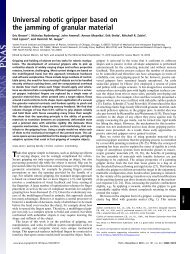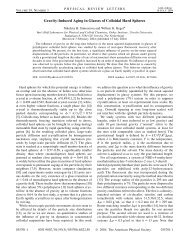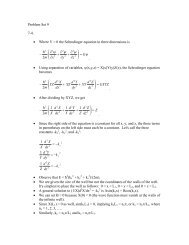Distribution of Glass Transition Temperatures in Free-Standing ...
Distribution of Glass Transition Temperatures in Free-Standing ...
Distribution of Glass Transition Temperatures in Free-Standing ...
Create successful ePaper yourself
Turn your PDF publications into a flip-book with our unique Google optimized e-Paper software.
ARTICLE<br />
pubs.acs.org/Macromolecules<br />
<strong>Distribution</strong> <strong>of</strong> <strong>Glass</strong> <strong>Transition</strong> <strong>Temperatures</strong> <strong>in</strong> <strong>Free</strong>-Stand<strong>in</strong>g,<br />
Nanoconf<strong>in</strong>ed Polystyrene Films: A Test <strong>of</strong> de Gennes’<br />
Slid<strong>in</strong>g Motion Mechanism<br />
Soyoung Kim † and John M. Torkelson* ,†,‡<br />
† Department <strong>of</strong> Chemical and Biological Eng<strong>in</strong>eer<strong>in</strong>g and ‡ Department <strong>of</strong> Materials Science and Eng<strong>in</strong>eer<strong>in</strong>g,<br />
Northwestern University, Evanston, Ill<strong>in</strong>ois 60208, United States<br />
bS Support<strong>in</strong>g Information<br />
ABSTRACT: Effects <strong>of</strong> nanoscale conf<strong>in</strong>ement on the distribution <strong>of</strong><br />
glass transition temperatures (T g s) <strong>in</strong> free-stand<strong>in</strong>g polystyrene (PS)<br />
films are determ<strong>in</strong>ed via a multilayer/self-referenc<strong>in</strong>g fluorescence method<br />
employ<strong>in</strong>g a pyrene dye label. Average film T g syieldaT g -conf<strong>in</strong>ement<br />
effect <strong>in</strong> agreement with the molecular weight (MW) dependence<br />
reported by Forrest, Dalnoki-Veress, and Dutcher. Multilayer films,<br />
with one pyrene-labeled layer, reveal that a 14 nm thick free-surface<br />
layer <strong>in</strong> sufficiently thick films (g∼56 nm) exhibits T g = T g,bulk ∼34 K,<br />
<strong>in</strong>dependent <strong>of</strong> film thickness and <strong>in</strong>dicative <strong>of</strong> a strong T g gradient near a<br />
surface. In sufficiently th<strong>in</strong> films (e∼56 nm), a 14 nm thick free-surface layer reports T g that decreases with decreas<strong>in</strong>g film thickness and<br />
is equal to the T g <strong>of</strong> a 14 nm thick middle layer and the average film T g . Thus, the strongly perturbed T g at the two surfaces affects T g several<br />
tens <strong>of</strong> nanometers <strong>in</strong>to and across the film, result<strong>in</strong>g <strong>in</strong> greater T g reductions than observed <strong>in</strong> supported films. This study also tests de<br />
Gennes’ “slid<strong>in</strong>g motion mechanism”, devised to expla<strong>in</strong> the MW dependence <strong>of</strong> the T g -conf<strong>in</strong>ement effect <strong>in</strong> free-stand<strong>in</strong>g films. No<br />
midlayer cha<strong>in</strong> <strong>in</strong> a multilayer film forms loops or bridges reach<strong>in</strong>g a surface. de Gennes’ mechanism <strong>in</strong>dicates that T g reductions occur only<br />
at locations where segments are present from cha<strong>in</strong>s form<strong>in</strong>g loops or bridges at a surface. Major T g reductions (as large as ∼54 K below<br />
T g,bulk ) are observed <strong>in</strong> midlayers <strong>of</strong> nanoconf<strong>in</strong>ed free-stand<strong>in</strong>g PS films, disprov<strong>in</strong>g a key premise <strong>of</strong> the mechanism.<br />
’ INTRODUCTION<br />
By us<strong>in</strong>g fluorophores to label a s<strong>in</strong>gle layer with<strong>in</strong> a multilayer<br />
nanoconf<strong>in</strong>ed, supported PS films with one free surface. 3 7,9 Published: May 10, 2011<br />
In 1994, Keddie, Jones, and Cory 1,2 published the first systematic PS film, Ellison and Torkelson 10 performed the first direct<br />
studies <strong>of</strong> the effect <strong>of</strong> conf<strong>in</strong>ement on the glass transition temperature<br />
(T g ) <strong>of</strong> th<strong>in</strong> polymer films. Us<strong>in</strong>g ellipsometry to characterize<br />
measurement <strong>of</strong> T g gradients <strong>in</strong> substrate-supported PS films.<br />
They measured T g at specific, targeted film locations, show<strong>in</strong>g<br />
T g via measurement <strong>of</strong> thickness as a function <strong>of</strong> temperature, they that the T g <strong>of</strong> a 14 nm thick PS free-surface layer atop a bulk PS<br />
observed reductions <strong>in</strong> T g with decreas<strong>in</strong>g thickness <strong>in</strong> ultrath<strong>in</strong> layer is reduced ∼32 K from its bulk value, consistent with the<br />
polystyrene (PS) films supported on silica and ultrath<strong>in</strong> polyidea<br />
that the T g -conf<strong>in</strong>ement effect <strong>in</strong> PS films orig<strong>in</strong>ates from a<br />
(methyl methacrylate) (PMMA) films supported on gold. They reduction <strong>in</strong> the free-surface layer T g . With the multilayer/<br />
observed no significant molecular weight (MW) dependence <strong>of</strong> the fluorescence method, they also showed that the perturbation<br />
T g -conf<strong>in</strong>ement effect and hypothesized that the reduction <strong>in</strong> T to T g <strong>in</strong> the free-surface layer can propagate <strong>in</strong>to a substratesupported<br />
PS film and perturb the glass transition response<br />
g<br />
with nanoscale conf<strong>in</strong>ement resulted from a liquidlike layer at the<br />
free surface with <strong>in</strong>creased mobility relative to bulk polymer. 1 several tens <strong>of</strong> nanometers away from the free surface. They<br />
S<strong>in</strong>ce then, many experimental and theoretical studies further demonstrated that the extent to which the local T g<br />
have focused on characteriz<strong>in</strong>g and understand<strong>in</strong>g the effect <strong>of</strong><br />
smoothly transitions from a reduced value near the free surface<br />
nanoconf<strong>in</strong>ement on T g and assorted, related behavior <strong>of</strong> polymers<br />
<strong>in</strong> th<strong>in</strong> film geometries. 3 7 Numerous experimental studies nanoconf<strong>in</strong>ement. 10 Multilayer/fluorescence studies have re-<br />
to bulk behavior <strong>in</strong> the film <strong>in</strong>terior depends strongly on<br />
have <strong>in</strong>vestigated average T g s <strong>of</strong> th<strong>in</strong> polymer films. The film<br />
vealed related behavior <strong>in</strong> other systems, 11 16 <strong>in</strong>clud<strong>in</strong>g ones<br />
geometry provides the comb<strong>in</strong>ed advantages <strong>of</strong> ease <strong>in</strong> quantitatively<br />
tun<strong>in</strong>g the level <strong>of</strong> conf<strong>in</strong>ement via sp<strong>in</strong>-coat<strong>in</strong>g 8 and simple substrate <strong>in</strong>terfaces lead<strong>in</strong>g to an <strong>in</strong>crease <strong>in</strong> polymer T g . These<br />
<strong>in</strong> which there are hydrogen-bond<strong>in</strong>g <strong>in</strong>teractions at polymer<br />
application with a range <strong>of</strong> methods for determ<strong>in</strong><strong>in</strong>g T g .Most<br />
methods have recently been adapted for related <strong>in</strong>vestigations<br />
<strong>of</strong>ten, these studies have concentrated on s<strong>in</strong>gle-layer PS films<br />
supported on silica substrates. There is general agreement among Received: March 17, 2011<br />
these studies that T g decreases with decreas<strong>in</strong>g thickness for Revised: April 29, 2011<br />
r 2011 American Chemical Society 4546 dx.doi.org/10.1021/ma200617j | Macromolecules 2011, 44, 4546–4553
Macromolecules<br />
<strong>in</strong>volv<strong>in</strong>g neutron reflectivity measurements 17 on multilayer<br />
films <strong>of</strong> hydrogenated and deuterated PS and dielectric spectroscopy<br />
studies <strong>of</strong> multilayer films with one layer conta<strong>in</strong><strong>in</strong>g<br />
polymer labeled at low levels with a high dipole moment dye. 18<br />
In a related molecular dynamics simulation study, Peter et al. 19<br />
found that average cooperative dynamics <strong>in</strong> a film are accelerated<br />
due to a smooth gradient <strong>in</strong> relaxation orig<strong>in</strong>at<strong>in</strong>g from the free<br />
surface, where segmental relaxation occurs much faster than <strong>in</strong><br />
the bulk. Further experimental support for enhanced mobility at<br />
the surface <strong>of</strong> polymer films comes from a variety <strong>of</strong> sources. For<br />
example, Fakhraai and Forrest 20 produced well-def<strong>in</strong>ed nanodeformations<br />
on the surface <strong>of</strong> supported PS films. They observed<br />
surface relaxation over a 277 369 K temperature range, far<br />
below T g,bulk and consistent with enhanced free-surface mobility.<br />
Tsui and co-workers 21 studied the viscosity <strong>of</strong> unentangled,<br />
short-cha<strong>in</strong> supported PS films, obta<strong>in</strong><strong>in</strong>g a Kauzmann temperature,<br />
T K , as a function <strong>of</strong> thickness by application <strong>of</strong> a Vogel<br />
Fulcher Tamman equation to the experimentally determ<strong>in</strong>ed<br />
temperature-dependent viscosity. They found a reduction <strong>in</strong> T K<br />
with decreas<strong>in</strong>g thickness below 20 nm. From hydrodynamic<br />
analysis and application <strong>of</strong> a two-layer model, they <strong>in</strong>terpreted<br />
that a highly mobile surface liquid layer was present with a<br />
thickness <strong>of</strong> less than 2.3 nm and <strong>in</strong>dicated that this mobile<br />
surface layer is responsible for the effects <strong>of</strong> conf<strong>in</strong>ement on the<br />
effective viscosity and the T g <strong>of</strong> PS films.<br />
In contrast to the many dozens <strong>of</strong> <strong>in</strong>vestigations <strong>of</strong> the<br />
T g -conf<strong>in</strong>ement effect and related behavior <strong>of</strong> polymer films<br />
supported on silica, fewer studies have focused on the T g -conf<strong>in</strong>ement<br />
effect and related properties <strong>of</strong> s<strong>in</strong>gle-layer free-stand<strong>in</strong>g<br />
films, 22 47 i.e., films with two polymer air <strong>in</strong>terfaces or free<br />
surfaces. Us<strong>in</strong>g Brillou<strong>in</strong> scatter<strong>in</strong>g and ellipsometry, Dutcher<br />
and co-workers 22 27 were the first group to characterize the<br />
T g -conf<strong>in</strong>ement effect <strong>in</strong> free-stand<strong>in</strong>g polymer films, do<strong>in</strong>g<br />
studies on PS and PMMA. The most strik<strong>in</strong>g features associated<br />
with their free-stand<strong>in</strong>g PS film studies are that the T g reductions<br />
can be much greater than those <strong>of</strong> PS films supported on silica<br />
(T g reductions as large as 70 80 K were reported <strong>in</strong> free-stand<strong>in</strong>g<br />
22<br />
films relative to bulk T 25 g ) and that at high MW there is a<br />
strong MW dependence <strong>of</strong> the T g reduction.<br />
Unlike free-stand<strong>in</strong>g PS films, <strong>in</strong> supported PS films there is no<br />
significant MW dependence <strong>of</strong> the T g -conf<strong>in</strong>ement effect. 48 This<br />
difference between free-stand<strong>in</strong>g and supported PS films is one <strong>of</strong><br />
the most <strong>in</strong>trigu<strong>in</strong>g results to arise from studies <strong>of</strong> the effects <strong>of</strong><br />
nanoscale conf<strong>in</strong>ement on glass-formers. de Gennes 29 proposed<br />
a simple physical picture <strong>of</strong> “slid<strong>in</strong>g motion” to expla<strong>in</strong> the cha<strong>in</strong>length<br />
dependence <strong>of</strong> T g <strong>in</strong> nanoconf<strong>in</strong>ed, free-stand<strong>in</strong>g films.<br />
He suggested that the mobility <strong>of</strong> a polymer cha<strong>in</strong> can be greatly<br />
enhanced if loops or bridges from the cha<strong>in</strong> extend to the surface<br />
region <strong>of</strong> the th<strong>in</strong> film. In de Gennes’ mechanism, the loops <strong>of</strong> a<br />
cha<strong>in</strong> present at a free surface can transport “k<strong>in</strong>ks” <strong>of</strong> free<br />
volume along the cha<strong>in</strong>’s own length, allow<strong>in</strong>g for faster structural<br />
relaxation and thereby <strong>in</strong>duc<strong>in</strong>g a reduction <strong>in</strong> local T g . The<br />
model leads to a function T g (z) which depends on the distance z<br />
from a free surface. As a result <strong>of</strong> the slid<strong>in</strong>g motion, T g is<br />
expected to decrease <strong>in</strong> regions near the free surface at distances<br />
comparable to the size <strong>of</strong> a polymer coil (i.e., the diameter <strong>of</strong> the<br />
volume pervaded by a cha<strong>in</strong>) because additional free volume can<br />
presumably be transported from the loops at the free surface over<br />
a thickness related to coil diameter. Conversely, with de Gennes’<br />
mechanism, bulk T g is expected <strong>in</strong> <strong>in</strong>terior regions <strong>of</strong> the film<br />
where no polymer cha<strong>in</strong> is present that has segments form<strong>in</strong>g<br />
loops at the free surface. This mechanism provides a potential<br />
ARTICLE<br />
explanation for the important role <strong>of</strong> MW on the T g -conf<strong>in</strong>ement<br />
effect <strong>in</strong> PS free-stand<strong>in</strong>g films and suggests a (semi)quantitative<br />
approach, based on the MW dependence <strong>of</strong> the polymer coil<br />
radius, to expla<strong>in</strong> this behavior.<br />
Here we employ a recently developed multilayer/self-referenc<strong>in</strong>g<br />
fluorescence method that yields T g values with<strong>in</strong> surface and<br />
<strong>in</strong>terior layers <strong>of</strong> known thickness. First reported <strong>in</strong> 2008, the<br />
self-referenc<strong>in</strong>g fluorescence method was developed to measure<br />
the T g -conf<strong>in</strong>ement effect <strong>in</strong> s<strong>in</strong>gle-layer free-stand<strong>in</strong>g PS films<br />
via the temperature dependence <strong>of</strong> a fluorescence <strong>in</strong>tensity ratio<br />
associated with a pyrenyl dye labeled to the polymer. 47 In most<br />
previous fluorescence studies <strong>of</strong> T g -conf<strong>in</strong>ement effects, fluorescence<br />
<strong>in</strong>tensity (at a specific wavelength or <strong>in</strong>tegrated over the<br />
whole spectrum) was measured as a function <strong>of</strong> temperature,<br />
with T g be<strong>in</strong>g obta<strong>in</strong>ed from the <strong>in</strong>tersection <strong>of</strong> the temperature<br />
dependences <strong>of</strong> the rubbery-state and glassy-state fluorescence<br />
<strong>in</strong>tensities. 6,10 16,48,49 However, such measurements do not<br />
yield accurate and precise T g determ<strong>in</strong>ations <strong>in</strong> free-stand<strong>in</strong>g<br />
films due to film rippl<strong>in</strong>g upon cool<strong>in</strong>g, result<strong>in</strong>g <strong>in</strong> changes <strong>in</strong> the<br />
surface area <strong>of</strong> the film exposed to fluorescence excitation light.<br />
Many pyrene-based dyes can exhibit strong sensitivity <strong>of</strong> fluorescence<br />
spectral shape to nanoscale environment, 50 54 and we<br />
discovered that the spectral shape <strong>of</strong> a pyrene dye covalently<br />
attached <strong>in</strong> a particular way to PS changes as a function <strong>of</strong><br />
temperature. 47 In turn, the use <strong>of</strong> an <strong>in</strong>tensity ratio to characterize<br />
the changes <strong>in</strong> spectral shape provides an accurate and precise<br />
self-referenc<strong>in</strong>g determ<strong>in</strong>ation <strong>of</strong> T g , <strong>in</strong>dependent <strong>of</strong> any change<br />
<strong>in</strong> the surface area <strong>of</strong> the film exposed to fluorescence excitation<br />
caused by film rippl<strong>in</strong>g. 47 In our 2008 study, data obta<strong>in</strong>ed by<br />
self-referenc<strong>in</strong>g fluorescence for average T g s across s<strong>in</strong>gle-layer<br />
free-stand<strong>in</strong>g PS films 47 were <strong>in</strong> reasonable agreement with<br />
results <strong>of</strong> Dutcher and co-workers; 22 25 a major reduction <strong>in</strong><br />
T g was evident with decreas<strong>in</strong>g thickness <strong>in</strong> films th<strong>in</strong>ner than<br />
80 90 nm, and the limited data set agreed with the MW<br />
dependence <strong>of</strong> the T g -conf<strong>in</strong>ement effect reported by Dutcher<br />
and co-workers.<br />
In particular, we have designed our current multilayer/fluorescence<br />
study to provide the first critical experimental test <strong>of</strong> de<br />
Gennes’ slid<strong>in</strong>g motion model <strong>in</strong> free-stand<strong>in</strong>g PS films. 29 By<br />
prepar<strong>in</strong>g trilayer films <strong>in</strong> which the middle layer conta<strong>in</strong>s<br />
pyrene-labeled PS and the two surface layers conta<strong>in</strong> neat PS<br />
without pyrene dye, we demonstrate for the first time that a<br />
major reduction <strong>in</strong> T g can be observed <strong>in</strong> the middle layer <strong>of</strong><br />
nanoconf<strong>in</strong>ed free-stand<strong>in</strong>g polymer films even when the cha<strong>in</strong>s<br />
with<strong>in</strong> that layer are unable to form loops at either <strong>of</strong> the two free<br />
surfaces. This contradicts a key premise <strong>of</strong> de Gennes’ model. We<br />
further compare our results for the distribution <strong>of</strong> T g s with<strong>in</strong> freestand<strong>in</strong>g<br />
nanoconf<strong>in</strong>ed PS films to those reported by Ellison and<br />
Torkelson 10 for supported nanoconf<strong>in</strong>ed PS films, demonstrat<strong>in</strong>g<br />
substantial agreement between the distributions <strong>of</strong> local T g <strong>in</strong><br />
these systems.<br />
’ EXPERIMENTAL SECTION<br />
1-Pyrenylmethyl methacrylate-labeled PS (MApyrene-labeled PS; 47<br />
M n = 805 000 g mol<br />
1 , M w /M n = 1.31, by gel permeation chromatography<br />
(GPC) relative to PS standards us<strong>in</strong>g tetrahydr<strong>of</strong>uran (THF) as<br />
eluent) was synthesized by bulk free radical polymerization <strong>of</strong> styrene<br />
(Aldrich) <strong>in</strong> the presence <strong>of</strong> trace amounts <strong>of</strong> 1-pyrenylmethyl methacrylate<br />
(MApyrene; Polysciences). The MApyrene-labeled PS was<br />
precipitated <strong>in</strong>to excess methanol and washed by redissolv<strong>in</strong>g <strong>in</strong> THF<br />
and precipitat<strong>in</strong>g <strong>in</strong> methanol seven times to remove any residual<br />
4547 dx.doi.org/10.1021/ma200617j |Macromolecules 2011, 44, 4546–4553
Macromolecules<br />
dye-labeled monomer before dry<strong>in</strong>g under vacuum. (The unusually low<br />
PDI for the MApyrene-labeled PS resulted from the method employed<br />
dur<strong>in</strong>g the multiple dissolution/precipitation steps used <strong>in</strong> remov<strong>in</strong>g<br />
unreacted dye-labeled monomer. With relatively weak precipitation<br />
conditions, there was a loss <strong>of</strong> lower MW fractions <strong>of</strong> the polymer,<br />
thereby result<strong>in</strong>g <strong>in</strong> a PDI that was well below 1.5 even though the<br />
polymer was synthesized by conventional free radical polymerization.)<br />
Bulk T g values were measured by differential scann<strong>in</strong>g calorimetry<br />
(DSC) (Mettler-Toledo 822e, second heat, onset method, 10 K/m<strong>in</strong>)<br />
and fluorescence methods (temperature dependence <strong>of</strong> <strong>in</strong>tensity ratios)<br />
agreed with<strong>in</strong> experimental error: T g,bulk = 373 K by DSC and<br />
fluorescence. The pyrene label content was 1.2 mol % relative to all<br />
polymer repeat units as measured by UV vis absorbance (Perk<strong>in</strong>-Elmer<br />
Lambda 35).<br />
Polystyrene, with a reported M n = 849 000 g mol<br />
1 and M w /M n =<br />
1.06, was used as received from Pressure Chemical. The onset bulk T g<br />
value was measured as 373 K by a DSC Mettler-Toledo 822e (second<br />
heat, onset method, 10 K/m<strong>in</strong>).<br />
S<strong>in</strong>gle-layer free-stand<strong>in</strong>g films were fabricated by us<strong>in</strong>g a water<br />
transfer technique. 55 Related details are discussed <strong>in</strong> ref 47. Film thickness<br />
was verified by sp<strong>in</strong>-coat<strong>in</strong>g a second film at the same time from the same<br />
solution onto a silicon slide with its native silicon oxide layer and<br />
measur<strong>in</strong>g its thickness via spectroscopic ellipsometry (J.A. Woollam<br />
Co. M-2000D).<br />
Bilayer and trilayer free-stand<strong>in</strong>g films were also fabricated by the<br />
water transfer technique. 55 Each layer was first prepared by sp<strong>in</strong>-coat<strong>in</strong>g 8<br />
dilute PS solutions onto freshly cleaved mica. These mica-supported<br />
<strong>in</strong>dividual layers were annealed separately at T g,bulk þ 20 K for 12 h<br />
under vacuum to remove residual solvent prior to float<strong>in</strong>g. The thickness<br />
<strong>of</strong> each layer was verified by sp<strong>in</strong>-coat<strong>in</strong>g a second film at the same time<br />
from the same solution onto a silicon slide with a native silicon oxide<br />
layer and measur<strong>in</strong>g its thickness via ellipsometry (J.A. Woollam Co.<br />
M-2000D). Multilayer films were assembled by sequentially float<strong>in</strong>g<br />
them onto underly<strong>in</strong>g polymer layers supported by mica. Excess water<br />
was evaporated under ambient conditions for at least 12 h before the<br />
next layer was added. Once assembled, all films were placed <strong>in</strong> a vacuum<br />
oven at room temperature for at least 12 h prior to measurement. Lastly,<br />
the assembled multilayer films were floated <strong>of</strong>f the mica and transferred<br />
onto nylon sample holders (washers) with 10 mm diameter holes.<br />
Both MApyrene-labeled and neat PS cha<strong>in</strong>s used <strong>in</strong> this study were <strong>of</strong><br />
sufficiently high MW to ensure that <strong>in</strong>terlayer diffusion occurred over at<br />
most 1 2 nm dur<strong>in</strong>g the experimental measurement time, <strong>in</strong>clud<strong>in</strong>g the<br />
time to create a consolidated film. Estimation <strong>of</strong> <strong>in</strong>terlayer diffusion <strong>of</strong><br />
similar bilayer films has been described elsewhere. 10,16,56<br />
Fluorescence was measured us<strong>in</strong>g a Photon Technology International<br />
fluorimeter with 3 6 nm bandpass excitation and 3 nm bandpass<br />
emission slits. Film temperature was controlled by a microprocessor<br />
controller (M<strong>in</strong>co Products) with a Kapton ribbon heater attached to a<br />
flat alum<strong>in</strong>um plate that was also used as a clamp<strong>in</strong>g device to hold the<br />
sample. For free-stand<strong>in</strong>g films, the nylon washers hold<strong>in</strong>g the polymer<br />
films were placed and clamped between two alum<strong>in</strong>um plates that had<br />
15 mm diameter holes <strong>in</strong> order to accommodate the excitation and<br />
emission <strong>of</strong> fluorescence from the freely stand<strong>in</strong>g films. A quartz cover<br />
was placed on top <strong>of</strong> the alum<strong>in</strong>um plates, and a clamp<strong>in</strong>g device held all<br />
the pieces together. The excitation wavelength was 324 nm, and the<br />
fluorescence emission <strong>in</strong>tensity was monitored at 370 415 nm.<br />
All fluorescence-based T g measurements were obta<strong>in</strong>ed upon cool<strong>in</strong>g<br />
from the rubbery or liquid state. Films that exhibited T g > 343 K<br />
(T g < 343 K) were <strong>in</strong>itially heated to at least T g þ 40 K (383 K) and held<br />
for a m<strong>in</strong>imum <strong>of</strong> 20 m<strong>in</strong> before measur<strong>in</strong>g the emission spectrum at<br />
elevated temperature <strong>in</strong> the rubbery state. The temperature was then<br />
decreased by 5 K at a time, and at each temperature the sample was held<br />
for 5 m<strong>in</strong> to ensure thermal equilibrium before measur<strong>in</strong>g the emission<br />
spectrum. In order to measure T g , we used the temperature dependence<br />
ARTICLE<br />
Figure 1. (a) Temperature dependence <strong>of</strong> the fluorescence emission<br />
spectrum <strong>of</strong> a 56 nm thick free-stand<strong>in</strong>g MApyrene-labeled PS film.<br />
(1.2 wt % <strong>of</strong> the polymer repat units conta<strong>in</strong> pyrene dye.) Spectra have<br />
been normalized to one by the peak <strong>in</strong>tensity <strong>in</strong> the 303 K emission<br />
spectrum. Arrows <strong>in</strong>dicate the approximate wavelengths at which I 1 and<br />
I 3 <strong>in</strong>tensities are measured. Inset: molecular structure <strong>of</strong> MApyrene. (b)<br />
Temperature dependence <strong>of</strong> the ratio <strong>of</strong> <strong>in</strong>tensities at the third and first<br />
peaks <strong>of</strong> a 56 nm thick MApyrene-labeled PS film. (Data were obta<strong>in</strong>ed<br />
upon cool<strong>in</strong>g.)<br />
<strong>of</strong> the ratio <strong>of</strong> the <strong>in</strong>tensity <strong>of</strong> the third peak to the <strong>in</strong>tensity <strong>of</strong> the first<br />
peak (I 3 /I 1 ) <strong>of</strong> the pyrenyl dye label emission spectrum. The <strong>in</strong>tensity<br />
ratio was obta<strong>in</strong>ed by divid<strong>in</strong>g the <strong>in</strong>tensity <strong>of</strong> the third peak maximum<br />
located at 386.0 ( 3.5 nm by the <strong>in</strong>tensity <strong>of</strong> the first peak maximum<br />
located at 375.0 ( 3.5 nm, and <strong>in</strong>tensities were averaged over a 1 2nm<br />
range (us<strong>in</strong>g data at each 0.5 nm). In fitt<strong>in</strong>g the temperature dependences<br />
<strong>of</strong> I 3 /I 1 <strong>in</strong> the rubbery and glassy states, data po<strong>in</strong>ts well outside T g<br />
were used for the l<strong>in</strong>ear fits. To <strong>in</strong>itiate the fitt<strong>in</strong>g procedure, data po<strong>in</strong>ts<br />
were added to the rubbery- and glassy-state l<strong>in</strong>ear regressions at<br />
the extrema <strong>in</strong> the temperature range <strong>of</strong> the data. Related details on<br />
determ<strong>in</strong>ation <strong>of</strong> T g values from fits to temperature-dependent fluorescence<br />
data are provided <strong>in</strong> previous<br />
6,10,47 49<br />
studies.<br />
’ RESULTS AND DISCUSSION<br />
Figure 1a illustrates the significant effect <strong>of</strong> temperature on the<br />
spectral shape <strong>of</strong> the fluorescence <strong>of</strong> MApyrene-labeled PS <strong>in</strong> a<br />
s<strong>in</strong>gle-layer 56 nm thick free-stand<strong>in</strong>g film. It is well-known that<br />
the ratio <strong>of</strong> the <strong>in</strong>tensity <strong>of</strong> the third peak to the <strong>in</strong>tensity <strong>of</strong> the<br />
first peak, I 3 /I 1 , <strong>of</strong> the pyrene emission spectrum is sensitive to<br />
polarity <strong>of</strong> the local dye environment. 50,51 (When excited-state<br />
pyrene is <strong>in</strong> a polar environment, its molecular orbitals distort,<br />
4548 dx.doi.org/10.1021/ma200617j |Macromolecules 2011, 44, 4546–4553
Macromolecules<br />
ARTICLE<br />
Figure 2. Thickness dependence <strong>of</strong> T g <strong>in</strong> nanoconf<strong>in</strong>ed free-stand<strong>in</strong>g<br />
MApyrene-labeled PS films: M n = 805 kg mol<br />
1 (solid black diamonds),<br />
M n = 701 kg mol<br />
1 (solid gray circles) from ref 47, and M n =<br />
1460 kg mol<br />
1 (solid gray triangle) from ref 47. The open square<br />
1<br />
symbols are T g values <strong>of</strong> PS free-stand<strong>in</strong>g films with M n = 691 kg mol<br />
reported by Dalnoki-Veress et al. 24,25 Diagonal l<strong>in</strong>es are best fits to data<br />
reported by Dalnoki-Veress et al.: 24,25 M n = 514 kg mol<br />
1 (dashed l<strong>in</strong>e),<br />
M n = 691 kg mol<br />
1 (solid l<strong>in</strong>e), M n = 1180 kg mol<br />
1 (dash-dot l<strong>in</strong>e),<br />
and M n = 2070 kg mol<br />
1 (dash-dot-dot l<strong>in</strong>e).<br />
result<strong>in</strong>g <strong>in</strong> an <strong>in</strong>crease <strong>of</strong> the <strong>in</strong>tensity <strong>of</strong> the 0 0 band (I 1 )<br />
relative to other peaks, 50,51 with I 3 /I 1 correlat<strong>in</strong>g quantitatively<br />
with solvent polarity sensed by pyrene. 50 ) Moreover, we have<br />
recently demonstrated that the temperature dependence <strong>of</strong> I 3 /I 1<br />
<strong>of</strong> pyrene dyes doped <strong>in</strong>to or covalently attached <strong>in</strong> specific<br />
ways to polymer yields T g values <strong>of</strong> polymer films. 47,57 Figure 1b<br />
provides plots <strong>of</strong> I 3 /I 1 as a function <strong>of</strong> temperature above and<br />
below the T g s <strong>of</strong> the 56 nm thick MApyrene-labeled PS freestand<strong>in</strong>g<br />
film. (The arrows <strong>in</strong> Figure 1a <strong>in</strong>dicate the approximate<br />
wavelengths at which the <strong>in</strong>tensities <strong>of</strong> the first and third<br />
fluorescence peaks are measured.) The l<strong>in</strong>es <strong>in</strong> Figure 1b are<br />
fits to the rubbery-state and glassy-state temperature data well above<br />
and below T g , the value <strong>of</strong> which is determ<strong>in</strong>ed from the <strong>in</strong>tersection<br />
<strong>of</strong> the two l<strong>in</strong>es, with T g =340Kor67°C for the 56 nm thick film.<br />
Figure 2 compares the T g s <strong>of</strong> MApyrene-labeled PS freestand<strong>in</strong>g<br />
films with M n = 805 kg mol<br />
1 (M w = 1055 kg mol<br />
1 )<br />
obta<strong>in</strong>ed <strong>in</strong> the present study us<strong>in</strong>g the self-referenc<strong>in</strong>g<br />
fluorescence method with data from ref 47 (also us<strong>in</strong>g the selfreferenc<strong>in</strong>g<br />
fluorescence method) for PS with M n = 701 kg mol<br />
1<br />
(M w = 917 kg mol<br />
1 ) and data by Dalnoki-Veress et al. 24,25 for<br />
PS with M n = 691 kg mol<br />
1 (M w = 767 kg mol<br />
1 ). The figure<br />
shows a T g -conf<strong>in</strong>ement effect <strong>in</strong> free-stand<strong>in</strong>g PS films over the<br />
thickness range 20 80 nm. Our data for the PS sample with M n =<br />
805 kg mol<br />
1 show the expected behavior, fall<strong>in</strong>g between the<br />
Dalnoki-Veress et al. fit l<strong>in</strong>es 24,25 for free-stand<strong>in</strong>g films with<br />
M n = 691 kg mol<br />
1 and M n = 1180 kg mol<br />
1 . It is also noteworthy<br />
that the T g s <strong>of</strong> the PS free-stand<strong>in</strong>g films with M n =<br />
805 kg mol<br />
1 <strong>in</strong> the current study are generally lower than the<br />
T g s obta<strong>in</strong>ed <strong>in</strong> our previous self-referenc<strong>in</strong>g fluorescence study<br />
<strong>of</strong> PS free-stand<strong>in</strong>g films with similar thicknesses but lower MW<br />
(M n = 701 kg mol<br />
1 ). For example, a 43 nm thick film with M n =<br />
805 kg mol<br />
1 exhibits a T g <strong>of</strong> 321 K or 48 °C (T g T g,bulk =<br />
1<br />
∼ 54 K), while a 41 nm thick film with M n = 701 kg mol<br />
exhibits a T g <strong>of</strong> 326 K or 53 °C(T g T g,bulk = ∼ 49 K). Overall,<br />
the data for s<strong>in</strong>gle-layer free-stand<strong>in</strong>g PS films with M n = 805 and<br />
701 kg mol<br />
1 obta<strong>in</strong>ed us<strong>in</strong>g the self-referenc<strong>in</strong>g fluorescence method<br />
are <strong>in</strong> reasonable agreement with (and reflect the MW dependence<br />
<strong>of</strong>) the data by Forrest, Dalnoki-Veress, and Dutcher. 24,25<br />
Figure 3. Temperature dependence <strong>of</strong> the ratio <strong>of</strong> <strong>in</strong>tensities at the<br />
third and first peaks (I 3 /I 1 ) <strong>of</strong> a 14 nm thick MApyrene-labeled PS freesurface<br />
layer (circles) and a 14 nm thick MApyrene-labeled PS middle<br />
layer (squares) <strong>in</strong> free-stand<strong>in</strong>g bulk PS films.<br />
Figure 3 shows the temperature dependence <strong>of</strong> I 3 /I 1 for a<br />
14 nm thick MApyrene-labeled PS free-surface layer and a 14 nm<br />
thick MApyrene-labeled PS middle layer <strong>in</strong> trilayer free-stand<strong>in</strong>g<br />
bulk PS films. The l<strong>in</strong>es <strong>in</strong> the plot are fits to the rubbery-state<br />
and glassy-state temperature data well above and below T g , the<br />
value <strong>of</strong> which is determ<strong>in</strong>ed from the <strong>in</strong>tersection. The 14 nm<br />
thick free-surface layer sitt<strong>in</strong>g atop a 500 nm thick neat PS<br />
underlayer (not supported on a substrate) yields T g T g,bulk =<br />
34 ( 3 K; the 14 nm thick middle layer sandwiched between<br />
500 nm thick neat PS layers exhibits bulk T g with<strong>in</strong> experimental<br />
error. These local T g s <strong>in</strong> the free-surface and middle layers are,<br />
with<strong>in</strong> experimental error, identical to the T g s reported by Ellison<br />
and Torkelson 10 with<strong>in</strong> similar layers <strong>of</strong> substrate-supported bulk<br />
PS films. They showed that a 14 nm thick free-surface layer sitt<strong>in</strong>g<br />
atop a 270 nm thick PS substrate-supported film yields T g T g,<br />
bulk = ∼ 32 K. 10 Also, when a 14 nm thick labeled middle layer<br />
was sandwiched between two 270 nm thick neat PS layers (with<br />
the underlayer supported by a silica substrate), the middle layer<br />
exhibited the bulk T g , 10 <strong>in</strong> accordance with our data <strong>in</strong> the trilayer<br />
bulk free-stand<strong>in</strong>g film. These results <strong>in</strong>dicate that the cooperative<br />
segmental mobility associated with T g very near the free<br />
surface <strong>of</strong> a bulk free-stand<strong>in</strong>g PS film is significantly greater than<br />
that <strong>of</strong> bulk PS and that similar behavior is observed <strong>in</strong> the freesurface<br />
layer <strong>of</strong> a bulk supported PS film.<br />
Figure 4 summarizes our results with 56 nm thick multilayer<br />
free-stand<strong>in</strong>g PS films, identical <strong>in</strong> thickness to the s<strong>in</strong>gle-layer<br />
film characterized <strong>in</strong> Figures 1 and 2. As shown <strong>in</strong> Figure 2, a<br />
56 nm thick s<strong>in</strong>gle-layer free-stand<strong>in</strong>g PS film with M n = 805 kg<br />
mol<br />
1 exhibits T g T g,bulk = ∼ 33 K. Us<strong>in</strong>g a 56 nm thick<br />
bilayer free-stand<strong>in</strong>g film, we f<strong>in</strong>d that the 14 nm thick<br />
4549 dx.doi.org/10.1021/ma200617j |Macromolecules 2011, 44, 4546–4553
Macromolecules<br />
ARTICLE<br />
Figure 4. T g T g,bulk <strong>in</strong> free-stand<strong>in</strong>g labeled PS films and layers: (a)<br />
s<strong>in</strong>gle-layer 56 nm thick film, (b) 14 nm thick free-surface layer with<strong>in</strong> a<br />
bilayer film <strong>of</strong> 56 nm total thickness, (c) 14 nm thick middle-layer with<strong>in</strong><br />
a trilayer film <strong>of</strong> 56 nm total thickness. (The data for I 3 /I 1 as a function <strong>of</strong><br />
temperature for the bilayer and trilayer films, result<strong>in</strong>g <strong>in</strong> T g determ<strong>in</strong>ations,<br />
are provided <strong>in</strong> the Support<strong>in</strong>g Information.)<br />
MApyrene-labeled surface layer exhibits a T g value (T g<br />
T g,bulk = 34 ( 3 K) that is with<strong>in</strong> error identical to the average<br />
T g <strong>of</strong> the s<strong>in</strong>gle-layer film. This surface layer T g is also identical<br />
with<strong>in</strong> error to the T g <strong>of</strong> a 14 nm thick free-surface layer atop a<br />
free-stand<strong>in</strong>g bulk PS film.<br />
Us<strong>in</strong>g a 56 nm thick trilayer free-stand<strong>in</strong>g film, we f<strong>in</strong>d that the<br />
14 nm thick labeled middle layer exhibits T g T g,bulk = 38 (<br />
3 K, which with<strong>in</strong> error agrees with the average T g <strong>of</strong> the 56 nm<br />
thick s<strong>in</strong>gle-layer film but is 38 K below the T g <strong>of</strong> a 14 nm thick<br />
middle layer <strong>in</strong> a bulk trilayer PS film. Thus, <strong>in</strong> comparison with a<br />
bulk free-stand<strong>in</strong>g film exhibit<strong>in</strong>g a large difference between the<br />
T g s <strong>in</strong> a 14 nm thick layer <strong>in</strong> the middle and at the free surface and<br />
thereby a gradient <strong>in</strong> T g across the film, no T g gradient is apparent<br />
us<strong>in</strong>g 14 nm thick labeled layers with<strong>in</strong> a 56 nm thick freestand<strong>in</strong>g<br />
PS film. We hypothesize that a much narrower distribution<br />
<strong>of</strong> T g s is present <strong>in</strong> nanoconf<strong>in</strong>ed films because the average<br />
cooperative dynamics associated with the middle layer T g are<br />
significantly impacted by the average cooperative segmental<br />
dynamics <strong>in</strong> the surface layers, at most ∼20 nm away. Thus,<br />
when the thickness <strong>of</strong> a PS free-stand<strong>in</strong>g film is 56 nm, the T g<br />
gradient is elim<strong>in</strong>ated (as characterized by 14 nm thick layers).<br />
A related suppression <strong>of</strong> a T g gradient was observed by Ellison<br />
and Torkelson 10 <strong>in</strong> sufficiently th<strong>in</strong> substrate-supported PS films:<br />
for bilayer films with a total thickness <strong>of</strong> 24 nm, a 12 nm thick<br />
labeled surface layer exhibited a T g that was with<strong>in</strong> error identical<br />
to the average T g across the film (T g,bulk 11 K).<br />
As shown <strong>in</strong> Figure 5, <strong>in</strong> the case <strong>of</strong> substrate-supported<br />
bilayer PS films (data from ref 10), when the total film thickness<br />
exceeds 60 nm, a 14 nm thick surface layer exhibits a T g that is<br />
32 K below T g,bulk . As the total thickness decreases below 60 nm<br />
and approaches 25 nm, there is a sharp <strong>in</strong>crease <strong>in</strong> the surface<br />
layer T g . At a total thickness below ∼25 nm, the surface layer<br />
exhibits a T g value that is with<strong>in</strong> error identical to the average<br />
across the film. As described <strong>in</strong> ref 10, these results for substratesupported<br />
PS films have been understood <strong>in</strong> the follow<strong>in</strong>g<br />
manner. At thicknesses exceed<strong>in</strong>g 60 nm, the films exhibit the<br />
full gradient <strong>in</strong> T g , from a sharply reduced local T g near the free<br />
Figure 5. Comparison <strong>of</strong> free-surface layer T g s <strong>in</strong> bilayer free-stand<strong>in</strong>g<br />
PS films to free-surface layer T g s <strong>in</strong> bilayer substrate-supported PS films.<br />
The black circles represent T g values <strong>of</strong> 14 nm thick labeled PS freesurface<br />
layers as a function <strong>of</strong> total thickness <strong>of</strong> bilayer free-stand<strong>in</strong>g PS<br />
films. The gray circles represent T g values <strong>of</strong> s<strong>in</strong>gle layer labeled PS freestand<strong>in</strong>g<br />
films with M n = 805 kg mol<br />
1 from Figure 2, and the solid black<br />
l<strong>in</strong>e is a best fit to the s<strong>in</strong>gle-layer T g values. The data are compared to<br />
results from ref 10 for substrate-supported PS films. Diamonds represent<br />
T g values identified by fluorescence <strong>in</strong>tensity for 14 nm thick labeled PS<br />
free-surface layers <strong>of</strong> bilayer supported films as a function <strong>of</strong> total bilayer<br />
film thickness. 10 The solid gray curve is a fit<strong>of</strong>T g (h)=T g,bulk [1 (A/h) δ ]<br />
to the thickness dependence data from s<strong>in</strong>gle layer pyrene-doped PS<br />
supported films <strong>in</strong> ref 10 (A =4.3,δ =2.0,andT g,bulk =373K).The<br />
horizontal l<strong>in</strong>e represents T g T g,bulk <strong>of</strong> the 14 nm thick free-surface layer<br />
which is <strong>in</strong>dependent <strong>of</strong> underlayer thickness and film geometry for both<br />
free-stand<strong>in</strong>g and substrate-supported films.<br />
surface to bulk T g with<strong>in</strong> the film <strong>in</strong>terior, observed <strong>in</strong> bulk PS<br />
films. When the total thickness is below ∼60 nm, the dynamics<br />
adjust to satisfy the constra<strong>in</strong>t that the T g gradient from surface to<br />
substrate is not too sharp and abrupt; i.e., when the substratesupported<br />
film is too th<strong>in</strong>, it cannot support the full gradient <strong>in</strong><br />
glass transition dynamics observed <strong>in</strong> bulk PS films. When the<br />
total thickness is below a critical value, ∼25 nm as observed via<br />
12 or 14 nm thick labeled surface layers, the thickness is<br />
<strong>in</strong>sufficient to accommodate a substantial, smooth gradient <strong>in</strong><br />
T g from surface to substrate.<br />
We note that the 56 nm thick free-stand<strong>in</strong>g PS film <strong>in</strong> our<br />
current study, which shows no T g gradient as determ<strong>in</strong>ed by<br />
14 nm thick labeled layers, is almost exactly twice the thickness<br />
for which an absence <strong>of</strong> a T g gradient was determ<strong>in</strong>ed by Ellison<br />
and Torkelson 10 <strong>in</strong> substrate-supported PS films (∼25 nm).<br />
These results suggest that ∼56 nm may be close to the critical<br />
thickness for PS free-stand<strong>in</strong>g films (with M n = 805 kg mol<br />
1 and<br />
possibly other MWs) at which T g gradients are suppressed (as<br />
observed with 14 nm thick labeled layers) because <strong>of</strong> the<br />
propagation <strong>of</strong> the strongly perturbed free-surface T g from<br />
both free surfaces across the film. This hypothesis is also<br />
supported by a recent experimental study by Napolitano and<br />
Wubbenhorst; 58 us<strong>in</strong>g dielectric spectroscopy, they showed<br />
that there is asymmetric broaden<strong>in</strong>g <strong>of</strong> the structural relaxation<br />
peak <strong>of</strong> PS free-stand<strong>in</strong>g films toward lower temperatures and<br />
that the broaden<strong>in</strong>g decreases with decreas<strong>in</strong>g thickness. They<br />
suggested that because <strong>of</strong> free-surface effects from both film<br />
surfaces, free-stand<strong>in</strong>g PS films th<strong>in</strong>ner than a threshold thickness<br />
cannot conta<strong>in</strong> any bulk component, result<strong>in</strong>g <strong>in</strong> the<br />
smaller broaden<strong>in</strong>g <strong>of</strong> the structural relaxation peak with<br />
decreas<strong>in</strong>g thickness.<br />
4550 dx.doi.org/10.1021/ma200617j |Macromolecules 2011, 44, 4546–4553
Macromolecules<br />
Figure 5 shows details <strong>of</strong> how the underlayer thickness <strong>of</strong> freestand<strong>in</strong>g<br />
bilayer PS films affects the T g <strong>of</strong> a 14 nm thick freesurface<br />
layer and compares these results to those for supported<br />
PS films from Ellison and Torkelson. 10 When the total thickness<br />
<strong>of</strong> a PS free-stand<strong>in</strong>g film is ∼56 nm or greater, the 14 nm thick<br />
surface layer exhibits a T g that is ∼34 K below bulk T g . With<strong>in</strong><br />
experimental error, this result is <strong>in</strong> agreement with the results for<br />
substrate-supported PS films show<strong>in</strong>g that the T g <strong>of</strong> a 14 nm thick<br />
free-surface layer is ∼32 K below bulk T g when the total film<br />
thickness exceeds ∼60 nm. However, when the total freestand<strong>in</strong>g<br />
PS film thickness decreases below ∼56 nm, the<br />
14 nm thick surface layer exhibits a T g that decreases below<br />
T g,bulk 34 K with decreas<strong>in</strong>g total film thickness and is with<strong>in</strong><br />
error identical to that <strong>of</strong> the average T g across the whole film; i.e.,<br />
the film exhibits no significant T g gradient as reported by 14 nm<br />
thick labeled layers. In particular, a 43 nm thick s<strong>in</strong>gle-layer freestand<strong>in</strong>g<br />
PS film exhibits T g = T g,bulk ∼54 K, which is with<strong>in</strong><br />
error ((2 3 K) identical to T g = T g,bulk ∼57 K exhibited by a<br />
14 nm thick free-surface layer <strong>in</strong> a 43 nm thick bilayer freestand<strong>in</strong>g<br />
PS film. This behavior is the opposite <strong>of</strong> that observed <strong>in</strong><br />
substrate-supported films with thicknesses <strong>in</strong> the range<br />
∼25 60 nm but similar to that observed <strong>in</strong> substrate-supported<br />
films with thicknesses less than ∼25 nm.<br />
The results <strong>of</strong> the free-stand<strong>in</strong>g PS films reported here and the<br />
results <strong>of</strong> the substrate-supported PS films reported by Ellison<br />
and Torkelson 10 are <strong>in</strong> substantial agreement with and complement<br />
each other. When total film thickness is ∼56 60 nm or<br />
greater, a 14 nm thick free-surface layer exhibits a T g value that is<br />
∼32 34 K below T g,bulk , regardless <strong>of</strong> whether the film is freestand<strong>in</strong>g<br />
or substrate-supported. This may be understood from<br />
the standpo<strong>in</strong>t that the local T g behavior at the opposite <strong>in</strong>terface<br />
(polymer air <strong>in</strong> the case <strong>of</strong> a free-stand<strong>in</strong>g film and polymer<br />
substrate <strong>in</strong> the case <strong>of</strong> a supported film) cannot propagate<br />
across a PS film <strong>of</strong> 56 60 nm thickness and thereby perturb the<br />
T g response <strong>of</strong> the labeled free-surface layer.<br />
With decreas<strong>in</strong>g thickness below ∼56 60 nm, a 14 nm thick<br />
free-surface layer exhibits a T g that is strongly perturbed by the<br />
nanoscale conf<strong>in</strong>ement <strong>of</strong> the whole film, with the surface-layer<br />
T g be<strong>in</strong>g impacted by the presence <strong>of</strong> the <strong>in</strong>terface (polymer air<br />
or polymer substrate) on the opposite side <strong>of</strong> the film. In the<br />
case <strong>of</strong> free-stand<strong>in</strong>g PS films, the presence <strong>of</strong> a second freesurface<br />
only several tens <strong>of</strong> nanometers away from the labeled<br />
free-surface layer perturbs the T g response <strong>of</strong> the labeled layer,<br />
result<strong>in</strong>g <strong>in</strong> net reduction <strong>in</strong> the observed T g <strong>in</strong> the free-surface<br />
layer and averaged across the film as a whole. In contrast, with<br />
substrate-supported PS films <strong>in</strong> the thickness range ∼25 60 nm,<br />
the propagation across the whole thickness <strong>of</strong> the T g behaviors<br />
present at both <strong>in</strong>terfaces not only <strong>in</strong>hibits a reduction <strong>of</strong> the freesurface<br />
layer T g but also results <strong>in</strong> an <strong>in</strong>crease <strong>in</strong> the free-surface<br />
layer T g with decreas<strong>in</strong>g thickness. With sufficiently th<strong>in</strong> supported<br />
PS films (less than ∼25 nm thick), the films are unable to<br />
support a significant gradient <strong>in</strong> T g dynamics across the film,<br />
lead<strong>in</strong>g to an apparent suppression <strong>of</strong> the T g gradient. This<br />
∼25 nm thickness is roughly one-half the thickness at which the<br />
apparent full suppression <strong>of</strong> the T g gradient is observed <strong>in</strong> freestand<strong>in</strong>g<br />
PS films, which is caused by the effects <strong>of</strong> two free<br />
surfaces propagat<strong>in</strong>g <strong>in</strong>to and across the free-stand<strong>in</strong>g films.<br />
While the results for the distribution <strong>of</strong> T g s obta<strong>in</strong>ed with our<br />
free-stand<strong>in</strong>g PS films can be understood to be consistent with<br />
the results for the distribution <strong>of</strong> T g s reported earlier 10 for<br />
substrate-supported PS films, they also refute a basic consequence<br />
associated with de Gennes’ “slid<strong>in</strong>g motion” mechanism. 28,29<br />
ARTICLE<br />
A key hypothesis <strong>of</strong> this mechanism is that the loops <strong>of</strong> a cha<strong>in</strong><br />
present at a free surface can transport “k<strong>in</strong>ks” <strong>of</strong> free volume along<br />
the cha<strong>in</strong>’s own length, allow<strong>in</strong>g for faster structural relaxation and<br />
thereby <strong>in</strong>duc<strong>in</strong>g a reduction <strong>in</strong> local T g <strong>in</strong>side the film. As discussed<br />
by B<strong>in</strong>der, 30 de Gennes’ slid<strong>in</strong>g motion mechanism yield<strong>in</strong>g faster<br />
structural relaxation can come <strong>in</strong>to play only when the film thickness<br />
is less than the radius (or, more quantitatively, less than ∼4 times<br />
the radius) <strong>of</strong> a cha<strong>in</strong> <strong>in</strong> the film, thereby allow<strong>in</strong>g the formation <strong>of</strong><br />
loops at the free surface from segments <strong>of</strong> cha<strong>in</strong>s that extend <strong>in</strong>to the<br />
middle <strong>of</strong> and possibly even across the film thickness. A consequence<br />
<strong>of</strong> this is that T g reductions are not expected <strong>in</strong> a middle layer<br />
<strong>of</strong> a consolidated trilayer film that has been constructed, as <strong>in</strong> the<br />
current study, to disallow any cha<strong>in</strong> <strong>in</strong> the middle layer from form<strong>in</strong>g<br />
loops at the free surface <strong>of</strong> the trilayer film.<br />
As mentioned earlier, both MApyrene-labeled and neat PS<br />
cha<strong>in</strong>s used <strong>in</strong> this study are <strong>of</strong> sufficiently high MW (M n =<br />
805 000 g mol<br />
1 and M w /M n = 1.31 for MApyrene-labeled PS<br />
and M n = 849 000 g mol<br />
1 and M w /M n = 1.06 for neat PS) to<br />
ensure that <strong>in</strong>terlayer diffusion occurs over at most 1 2nm<br />
dur<strong>in</strong>g the experimental measurement time, which <strong>in</strong>cludes the<br />
time to create a consolidated film. 10,16,56 Given this fact, <strong>in</strong> our<br />
56 nm thick PS trilayer free-stand<strong>in</strong>g film, no MApyrene-labeled<br />
PS cha<strong>in</strong> <strong>in</strong> a 14 nm thick middle layer can form loops or bridges<br />
<strong>in</strong> contact with the free surfaces. However, as shown <strong>in</strong> Figures 3<br />
and 4, the 14 nm thick middle layer <strong>of</strong> the 56 nm thick PS trilayer<br />
free-stand<strong>in</strong>g film exhibits a T g that with<strong>in</strong> error is identical to the<br />
T g <strong>of</strong> 14 nm thick surface layers and the overall average T g with<strong>in</strong><br />
a s<strong>in</strong>gle-layer 56 nm thick film.<br />
The results <strong>of</strong> our multilayer free-stand<strong>in</strong>g film study can be<br />
understood by appreciat<strong>in</strong>g that the average cooperative segmental<br />
dynamics associated with T g with<strong>in</strong> a middle layer at a<br />
particular film depth are impacted by the strongly perturbed,<br />
average cooperative dynamics present several tens <strong>of</strong> nanometers<br />
away near the free surface, without the need for cha<strong>in</strong>s with<strong>in</strong> the<br />
middle layer to have segments form<strong>in</strong>g loops at polymer air<br />
<strong>in</strong>terfaces. This also expla<strong>in</strong>s why the onset thickness for and the<br />
size <strong>of</strong> the T g reduction relative to T g,bulk with decreas<strong>in</strong>g thickness<br />
are larger <strong>in</strong> free-stand<strong>in</strong>g than <strong>in</strong> substrate-supported PS films.<br />
Our current study and previous work 47 provide support for the<br />
MW dependence <strong>of</strong> the T g -conf<strong>in</strong>ement effect <strong>in</strong> free-stand<strong>in</strong>g<br />
PS films reported by Dutcher and co-workers, 22 25 which is not<br />
observed <strong>in</strong> substrate-supported PS films. 48 Our current study<br />
and previous work 10,47,48 on free-stand<strong>in</strong>g and substrate-supported<br />
films applied thermal histories prior to and dur<strong>in</strong>g measurement<br />
that were similar to each other but different from those used by<br />
Dutcher and co-workers 22 25 <strong>in</strong> their free-stand<strong>in</strong>g film studies.<br />
This <strong>in</strong>dicates that experimental artifacts such as the specific<br />
anneal<strong>in</strong>g conditions used by Dutcher and co-workers are not<br />
the orig<strong>in</strong> <strong>of</strong> the strong effect <strong>of</strong> MW on the T g -conf<strong>in</strong>ement<br />
behavior observed <strong>in</strong> free-stand<strong>in</strong>g PS films. F<strong>in</strong>ally, outside <strong>of</strong><br />
refut<strong>in</strong>g the “slid<strong>in</strong>g motion” model by de Gennes, 21 our current<br />
study does not yield an understand<strong>in</strong>g <strong>of</strong> this effect or suggest an<br />
orig<strong>in</strong> for this effect.<br />
We note that Lipson and Milner 40,41 recently considered<br />
the effects <strong>of</strong> MW on the T g -conf<strong>in</strong>ement effect <strong>in</strong> free-stand<strong>in</strong>g<br />
and semi-<strong>in</strong>f<strong>in</strong>ite PS films. Follow<strong>in</strong>g de Gennes’ “slid<strong>in</strong>g<br />
mechanism”, 28,29 they developed a delayed glassification theory<br />
to predict quantitatively the effects <strong>of</strong> MW and film thickness on<br />
T g for both semi-<strong>in</strong>f<strong>in</strong>ite (related to substrate-supported) and<br />
free-stand<strong>in</strong>g film geometries. They constructed a quantitative<br />
description <strong>of</strong> the <strong>in</strong>fluences <strong>of</strong> the free surface and polymer MW<br />
on average T g via transmission <strong>of</strong> “k<strong>in</strong>ks” or “free volume” along<br />
4551 dx.doi.org/10.1021/ma200617j |Macromolecules 2011, 44, 4546–4553
Macromolecules<br />
the cha<strong>in</strong> backbone from loops start<strong>in</strong>g or end<strong>in</strong>g at the free<br />
surface. In semi-<strong>in</strong>f<strong>in</strong>ite and free-stand<strong>in</strong>g PS films, their<br />
approach yields dramatic reductions <strong>in</strong> average T g relative to<br />
the bulk value with decreas<strong>in</strong>g film thickness, as observed <strong>in</strong><br />
many experimental studies. While their calculations yielded a<br />
significant MW dependence <strong>of</strong> average T g <strong>in</strong> free-stand<strong>in</strong>g films,<br />
qualitatively <strong>in</strong> accord with experiment, the MW dependence<br />
disappeared <strong>in</strong> the th<strong>in</strong>nest films, the opposite <strong>of</strong> what is observed<br />
<strong>in</strong> the experimental studies by Dutcher and co-workers. 22 25 This<br />
result may be taken as further evidence aga<strong>in</strong>st the “slid<strong>in</strong>g<br />
mechanism”. Their calculations also yielded <strong>in</strong>terest<strong>in</strong>g results <strong>in</strong><br />
semi-<strong>in</strong>f<strong>in</strong>ite films, with a prediction <strong>of</strong> a MW dependence <strong>of</strong> the<br />
T g reported from a labeled top layer (with variable thickness h)<strong>in</strong>a<br />
semi-<strong>in</strong>f<strong>in</strong>ite bilayer film. Lipson and Milner 41 stated that their<br />
model predictions for this case had not yet been experimentally<br />
tested, suggest<strong>in</strong>g that studies were needed to determ<strong>in</strong>e whether a<br />
MW effect is evident <strong>in</strong> the h-dependence <strong>of</strong> the free-surface layer<br />
T g <strong>in</strong> semi-<strong>in</strong>f<strong>in</strong>ite films.<br />
A comparison <strong>of</strong> the results <strong>of</strong> our present study with those <strong>of</strong><br />
Ellison and Torkelson 10 reveals the same T g reduction with<strong>in</strong><br />
error (T g = T g,bulk ∼32 34 K) <strong>in</strong> 14 nm thick free-surface<br />
layers sitt<strong>in</strong>g atop free-stand<strong>in</strong>g and substrate-supported PS films<br />
with overall thickness greater than or equal to ∼56 60 nm.<br />
(In such film geometries, the substrate-supported film corresponds<br />
to a semi-<strong>in</strong>f<strong>in</strong>ite film when the film thickness is<br />
sufficiently large to suppress any effect <strong>of</strong> the substrate on the<br />
response <strong>of</strong> the free-surface layer.) However, the PS samples<br />
used <strong>in</strong> the current study and by Ellison and Torkelson 10 differ by<br />
nearly a factor <strong>of</strong> 2 <strong>in</strong> M n values, 805 kg mol<br />
1 vs 440 kg mol<br />
1 ,<br />
and have MWs exactly <strong>in</strong> the range where Lipson and Milner 41<br />
predicted the largest effect <strong>of</strong> MW on the PS free-surface<br />
layer T g . Clearly, this limited experimental comparison does<br />
not provide a comprehensive test <strong>of</strong> the predictions <strong>of</strong> the<br />
Lipson Milner model, which <strong>in</strong> turn is related to (i.e., develops<br />
the detailed consequences <strong>of</strong> the basic idea <strong>of</strong>) de Gennes’ slid<strong>in</strong>g<br />
motion mechanism. However, our results do not suggest that a<br />
significant MW dependence, which is absent <strong>in</strong> the T g -conf<strong>in</strong>ement<br />
effect <strong>in</strong> s<strong>in</strong>gle-layer supported PS films, will be experimentally<br />
observed <strong>in</strong> nanoconf<strong>in</strong>ed free-surface layers atop semi<strong>in</strong>f<strong>in</strong>ite<br />
PS films.<br />
Further studies <strong>of</strong> the type undertaken <strong>in</strong> the present study<br />
and by Ellison and Torkelson 10 may provide a fully comprehensive<br />
test <strong>of</strong> the predictions <strong>of</strong> the model by Lipson and Milner. 41<br />
Additional self-referenc<strong>in</strong>g fluorescence studies <strong>of</strong> free-stand<strong>in</strong>g<br />
films <strong>of</strong> polymers other than PS are also warranted, as are<br />
<strong>in</strong>vestigations <strong>of</strong> effects <strong>of</strong> conf<strong>in</strong>ement on polymer properties<br />
other than T g . F<strong>in</strong>ally, further experimental and theoretical<br />
<strong>in</strong>vestigations will be needed to unravel the puzzle that rema<strong>in</strong>s<br />
associated with the different roles <strong>of</strong> MW <strong>in</strong> the T g -conf<strong>in</strong>ement<br />
effects <strong>in</strong> free-stand<strong>in</strong>g and supported PS films.<br />
’ ASSOCIATED CONTENT<br />
b S Support<strong>in</strong>g Information. Figure S1 reports data for<br />
I 3 /I 1 as a function <strong>of</strong> temperature for the bilayer and trilayer films<br />
<strong>in</strong> Figure 4, result<strong>in</strong>g <strong>in</strong> T g determ<strong>in</strong>ations. This material is<br />
available free <strong>of</strong> charge via the Internet at http://pubs.acs.org.<br />
’ AUTHOR INFORMATION<br />
Correspond<strong>in</strong>g Author<br />
*E-mail: j-torkelson@northwestern.edu.<br />
ARTICLE<br />
’ ACKNOWLEDGMENT<br />
We acknowledge the support <strong>of</strong> the NSF-MRSEC Program<br />
(Grant DMR-0520513), Northwestern University, and a<br />
Term<strong>in</strong>al-Year Fellowship (to S.K).<br />
’ REFERENCES<br />
(1) Keddie, J. L.; Jones, R. A. L.; Cory, R. A. Europhys. Lett. 1994,<br />
27, 59–64.<br />
(2) Keddie, J. L.; Jones, R. A. L.; Cory, R. A. Faraday Discuss. 1994,<br />
98, 219–230.<br />
(3) Forrest, J. A.; Dalnoki-Veress, K. Adv. Colloid Interface Sci. 2001,<br />
94, 167–196.<br />
(4) Alcoutlabi, M.; McKenna, G. B. J. Phys.: Condens. Matter 2005,<br />
17, R461–R524.<br />
(5) Roth, C. B.; Dutcher, J. R. J. Electroanal. Chem. 2005, 584,13–22.<br />
(6) Kim, S.; Hewlett, S. A.; Roth, C. B.; Torkelson, J. M. Eur. Phys. J. E<br />
2009, 30, 83–92.<br />
(7) Reiter, G.; Napolitano, S. J. Polym. Sci., Part B: Polym. Phys. 2010,<br />
48, 2544–2547.<br />
(8) Hall, D. B.; Underhill, P.; Torkelson, J. M. Polym. Eng. Sci. 1998,<br />
38, 2039–2045.<br />
(9) In contrast to the dozens <strong>of</strong> studies cited <strong>in</strong> refs 3 7 not<strong>in</strong>g a<br />
significant dependence <strong>of</strong> T g on thickness <strong>in</strong> nanoconf<strong>in</strong>ed PS films as<br />
measured by a wide array <strong>of</strong> experimental techniques and researchers, we<br />
note that there are a small number <strong>of</strong> reports <strong>in</strong>dicat<strong>in</strong>g the absence <strong>of</strong><br />
such a dependence. See, for example, the follow<strong>in</strong>g: Tress, M.; Erber, M.;<br />
Mapesa, E. U.; Huth, H.; Muller, J.; Serghei, A.; Schick, C.; Eichhorn,<br />
K. J.; Volt, B.; Kremer, F. Macromolecules 2010, 43, 9937–9944.<br />
(10) Ellison, C. J.; Torkelson, J. M. Nature Mater. 2003, 2, 695–700.<br />
(11) Ellison, C. J.; Torkelson, J. M. J. Polym. Sci., Part B: Polym. Phys.<br />
2002, 40, 2745–2758.<br />
(12) Priestley, R. D.; Broadbelt, L. J.; Torkelson, J. M. Macromolecules<br />
2005, 38, 654–657.<br />
(13) Priestley, R. D.; Ellison, C. J.; Broadbelt, L. J.; Torkelson, J. M.<br />
Science 2005, 309, 456–459.<br />
(14) Roth, C. B.; McNerny, K. L.; Jager, W. F.; Torkelson, J. M.<br />
Macromolecules 2007, 40, 2568–2574.<br />
(15) Roth, C. B.; Torkelson, J. M. Macromolecules 2007,<br />
40, 3328–3336.<br />
(16) Priestley, R. D.; Mundra, M. K.; Barnett, N.; Broadbelt, L. J.;<br />
Torkelson, J. M. Aust. J. Chem. 2007, 60, 765–771.<br />
(17) Inoue, R.; Kawashima, K.; Matsui, K.; Kanaya, T.; Nishida, K.;<br />
Matsuba, G.; H<strong>in</strong>o, M. Phys. Rev. E 2011, 83, 021801.<br />
(18) (a) Priestley, R. D.; Broadbelt, L. J.; Torkelson, J. M.; Fukao,<br />
K. Phys. Rev. E 2007, 75, 061806.(b) Priestley, R. D. Ph.D. Thesis,<br />
Northwestern University, 2008.<br />
(19) Peter, S.; Napolitano, S.; Meyer, H.; Wubbenhorst, M.;<br />
Baschnagel, J. Macromolecules 2008, 41, 7729–7743.<br />
(20) Fakhraai, Z.; Forrest, J. A. Science 2008, 319, 600–604.<br />
(21) Yang, Z. H.; Fujii, Y.; Lee, F. K.; Lam, C. H.; Tsui., O. K. C.<br />
Science 2010, 328, 1676–1679.<br />
(22) Forrest, J. A.; Dalnoki-Veress, K.; Dutcher, J. R. Phys. Rev. E<br />
1997, 56, 5705–5716.<br />
(23) Forrest, J. A.; Dalnoki-Veress, K.; Stevens, J. R.; Dutcher, J. R.<br />
Phys. Rev. Lett. 1996, 77, 2002–2005.<br />
(24) Dalnoki-Veress, K.; Forrest, J. A.; de Gennes, P. G.; Dutcher,<br />
J. R. J. Phys. IV 2000, 10, 221–226.<br />
(25) Dalnoki-Veress, K.; Forrest, J. A.; Murray, C.; Gigault, C.;<br />
Dutcher, J. R. Phys. Rev. E 2001, 63, 031801.<br />
(26) Roth, C. B.; Dutcher, J. R. Eur. Phys. J. E 2003, 12, S103–S107.<br />
(27) Roth, C. B.; Pound, A.; Kamp, S. W.; Murray, C. A.; Dutcher,<br />
J. R. Eur. Phys. J. E 2006, 20, 441–448.<br />
(28) de Gennes, P. G. C. R. Acad. Sci., Ser. IV: Phys., Astrophys. 2000,<br />
1, 1179–1186.<br />
(29) de Gennes, P. G. Eur. Phys. J. E 2000, 2, 201–203.<br />
(30) B<strong>in</strong>der, K. Eur. Phys. J. E 2000, 2, 204.<br />
4552 dx.doi.org/10.1021/ma200617j |Macromolecules 2011, 44, 4546–4553
Macromolecules<br />
ARTICLE<br />
(31) Mattsson, J.; Forrest, J. A.; Borjesson, L. Phys. Rev. E 2000,<br />
62, 5187–5200.<br />
(32) Liem, H.; Cabanillas-Gonzalez, J.; Etchego<strong>in</strong>, P.; Bradley,<br />
D. D. C. J. Phys.: Condens. Matter. 2004, 16, 721–728.<br />
(33) Miyazaki, T.; Inoue, R.; Nishida, K.; Kanaya, T. Eur. Phys. J.<br />
Spec. Top. 2007, 141, 203–206.<br />
(34) Svanberg, C. Macromolecules 2007, 40, 312–315.<br />
(35) O’Connell, P. A.; Hutcheson, S. A.; McKenna, G. B. J. Polym.<br />
Sci., Part B: Polym. Phys. 2008, 46, 1952–1965.<br />
(36) O’Connell, P. A.; McKenna, G. B. Eur. Phys. J. E 2006, 20,<br />
143–150.<br />
(37) O’Connell, P. A.; McKenna, G. B. Science 2005, 307, 1760–<br />
1763.<br />
(38) Ja<strong>in</strong>, T. S.; de Pablo, J. J. Phys. Rev. Lett. 2004, 92, 155505.<br />
(39) Rotella, C.; Napolitano, S.; Wubbenhorst, M. Macromolecules<br />
2009, 42, 1415–1417.<br />
(40) Lipson, J. E. G.; Milner, S. T. Macromolecules 2010, 43, 9874–9880.<br />
(41) Milner, S. T.; Lipson, J. E. G. Macromolecules 2010, 43,<br />
9865–9873.<br />
(42) Peter, S.; Meyer, H.; Baschnagel, J. J. Phys.: Condens. Matter<br />
2007, 19, 205119.<br />
(43) Jones, R. A. L. Eur. Phys. J. E 2000, 2, 205.<br />
(44) Baljon, A. R. C.; Williams, S.; Balabaev, N. K.; Paans, F.;<br />
Hudz<strong>in</strong>skyy, D.; Lyul<strong>in</strong>, A. V. J. Polym. Sci., Part B: Polym. Phys. 2010,<br />
48, 1160–1167.<br />
(45) Lipson, J. E. G.; Milner, S. T. Eur. Phys. J. B 2009, 72, 133–137.<br />
(46) Stevenson, J. D.; Wolynes, P. G. J. Chem. Phys. 2008, 129,<br />
324514.<br />
(47) Kim, S.; Roth, C. B.; Torkelson, J. M. J. Polym. Sci., Part B:<br />
Polym. Phys. 2008, 46, 2754–2764.<br />
(48) Ellison, C. J.; Mundra, M. K.; Torkelson, J. M. Macromolecules<br />
2005, 38, 1767–1778.<br />
(49) Rittigste<strong>in</strong>, P.; Torkelson, J. M. J. Polym. Sci., Part B: Polym. Phys.<br />
2006, 44, 2935–2943.<br />
(50) Kalyanasundaram, K.; Thomas, J. K. J. Am. Chem. Soc. 1977,<br />
99, 2039–2044.<br />
(51) Nakashima, K.; W<strong>in</strong>nik, M. A.; Dai, K. H.; Kramer, E. J.;<br />
Washiyama, J. Macromolecules 1992, 25, 6866–6870.<br />
(52) Kim, S. D.; Torkelson, J. M. Macromolecules 2002, 35, 5943–5952.<br />
(53) Duhamel, J. In Molecular Interfacial Phenomena <strong>of</strong> Polymers and<br />
Biopolymers; Chen, P., Ed.; Woodhead Publish<strong>in</strong>g: Cambridge, England,<br />
2005; pp 214 248.<br />
(54) Colambani, O.; Ruppel, M.; Schubert, F.; Zettl, H.; Pergushov,<br />
D. V.; Muller, A. H. E. Macromolecules 2007, 40, 4338–4350.<br />
(55) Roth, C. B.; Pound, A.; Kamp, S. W.; Murray, C. A.; Dutcher,<br />
J. R. Eur. Phys. J. E 2006, 20, 441–448.<br />
(56) Whitlow, S. J.; Wool, R. P. Macromolecules 1991, 24, 5926–5938.<br />
(57) As described <strong>in</strong> ref 53, free pyrene dye and pyrene covalently<br />
attached to a polymer via a methylene l<strong>in</strong>k<strong>in</strong>g group exhibit I 3 /I 1 values<br />
that are strongly sensitive to polarity; however, a longer l<strong>in</strong>k<strong>in</strong>g group<br />
leads to a loss <strong>of</strong> sensitivity to polarity. We demonstrated <strong>in</strong> ref 47 that<br />
the temperature dependence <strong>of</strong> I 3 /I 1 yields a clear determ<strong>in</strong>ation <strong>of</strong> the<br />
T g <strong>of</strong> supported and free-stand<strong>in</strong>g polymer films when the pyrene dye is<br />
attached to the polymer via a methylene l<strong>in</strong>k<strong>in</strong>g unit, as <strong>in</strong> the case <strong>of</strong><br />
1-pyrenylmethyl methacrylate-labeled PS (MApyrene-labeled PS).<br />
However, when a butylene l<strong>in</strong>k<strong>in</strong>g unit is used, as with 1-pyrenylbutyl<br />
methacrylate-labeled PS (BApyrene-labeled PS <strong>in</strong> ref 47), T g cannot be<br />
determ<strong>in</strong>ed via the temperature dependence <strong>of</strong> I 3 /I 1 <strong>of</strong> supported or<br />
free-stand<strong>in</strong>g polymer films, although the temperature dependence <strong>of</strong><br />
the <strong>in</strong>tegrated fluorescence <strong>in</strong>tensity (across the whole emission<br />
spectrum) yields T g <strong>in</strong> supported polymer films.<br />
(58) Napolitano, S.; Wubbenhorst, M. Polymer 2010, 51, 5309–<br />
5312.<br />
4553 dx.doi.org/10.1021/ma200617j |Macromolecules 2011, 44, 4546–4553



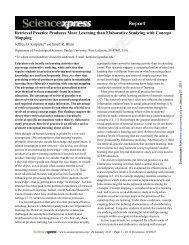



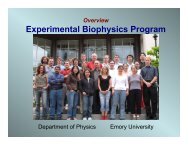


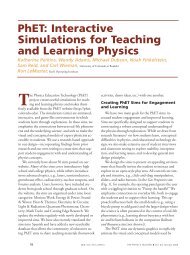
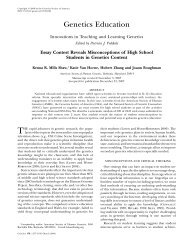
![view the Dish Show [PDF] - Department of Physics - Emory University](https://img.yumpu.com/45032745/1/190x146/view-the-dish-show-pdf-department-of-physics-emory-university.jpg?quality=85)

